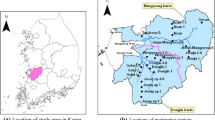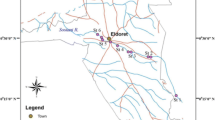Abstract
Multivariate techniques have been often used to compare and classify sampling sites. Here, it was used to make a quick assessment of the impact caused by flow modifications for Vishnuprayag and Srinagar hydroelectric projects on the producer communities constituting first trophic level of the Alaknanda River in Himalaya. For this study, the diatom communities were sampled during October, November, and February from flowing sections at three stations in each HEP; one u/s of dam, other two d/s of dam and powerhouse (PH). Species count was generated for each station. Both nonmetric multidimensional scaling (NMDS) and cluster analysis revealed two and three groups of locations, respectively, for 3- and 12-month data set. In case of the former, free-flowing S3 and deep column S5 were forming a subcluster, but no reasons were evident, as these were diametrically opposite locations, making it difficult to interpret. In case of the latter, the grouping was more reasonable as S2–S3 exhibit higher similarity, while S5 is distinct and S1 remained as an outlier. The study suggest that there is rapid change in diatom community structure disrupting River Continuum Concept (RCC), possibly due to modified hydrological regimes in longitudinally placed locations of the river resulting in separate subgroups. Analysis with large and small (data deficient) sample size shows differences in NMDS and cluster groupings, which appear to be irrelevant, demonstrating poor efficacy. Larger sample size was found to make the analysis more robust.
Access provided by Autonomous University of Puebla. Download chapter PDF
Similar content being viewed by others
Keywords
3.1 Introduction
Univariate, bivariate, and multivariate statistical techniques are generally used to study biotic communities. Of these, NMDS, PCA, CCA, and RDA are commonly used ordination techniques (Anderson et al. 2006; Nautiyal & Mishra 2013; White et al. 2016; Zhao et al. 2019; Ko et al. 2020).These techniques have been used to study drivers of diatom community structure in unimpacted (Soininen et al. 2004; Virtanen & Soininen 2012; Verma et al. 2016) and human impacted regions (Hlubikova et al. 2014; Nautiyal et al. 2015; Quevedo et al. 2018; Mutinova et al. 2020).
River Alaknanda is impacted by a series of two hydroelectric projects within a distance of ~140 km, as dam and power house modify the river flow in this stretch and disrupt the continuum. We presume that the community will be impacted in contrast to expected gradual change in community (RCC; Vannote et al. 1980). The purpose of this study is quick assessment (Chessman et al. 1999) of the river ecosystem using multivariate techniques. Nonmetric multidimensional scaling and cluster analysis are used to capture the changes in diatom community in a river serially impacted by hydroelectric projects. NMDS is used to compare the sampling sites in a two-dimensional plot in which sites with similar community structure are located close together compared to those far apart. Cluster analysis was used to classify sampling sites based on similar or dissimilar species abundance. This study can be useful in the management of river ecosystem health. In order to know the robustness of the statistical analysis, a 12-month data set for all other stations except S1 and S2 was subjected to NMDS and cluster analysis.
3.2 Study Area
Alaknanda is one of the major tributaries of the river Ganges. The river is impacted by two hydroelectric projects: one in headwaters, Vishnuprayag hydroelectric project (VHEP), and another in lower stretch, Srinagar hydroelectric projects (SHEP). The following six sampling locations were selected for this study: S1, 1 km u/s from the VHEP with steep slope; S2, d/s of the VHEP flow-deficient section; S3, 53 km d/s of VHEP power house (PH); S4, 30 km d/s from S3, considered as free-flowing section; S5, 1.5 u/s from the tail of SHEP impoundment; and S8, the station below the PH carrying regulated discharge from the SHEP.
3.3 Methods
Two types of samples were obtained: 3-month (small) and 12-month (large) data set. These sets differ in containing 3-month data from S1 to S8 compared with 3/4 months for S1 and S2 (not accessible) and 12 months for S3 to S8. Diatoms samples were collected by scraping 3 × 3 cm2 area of cobbles from the sampling sites. Two replicates of samples were collected in sampling vials. Acid-peroxide treatment was used to clean the diatom frustule. Permanent slides were prepared using Naphrax (RI 1.74) and observed under BX 40 Trinocular Olympus microscope. Diatom count data was generated for NMDS and cluster analysis using CAP ver. 4.0. Ward’s method (Bray-Curtis measure) was used to record distances and classify the stations. In order to detect robustness of results, small and large data sets were compared.
3.4 Results and Discussion
Multivariate and ordination techniques have been used to study composition of diatom flora, diversity, macroinvertebrate assemblages (Mishra & Nautiyal 2017), and fish fauna (Nautiyal et al. 2014) in the Ganga river from source in the Himalaya to Upper Gangetic Plains and in the Bundelkhand Plateau rivers. This study moves a step forward to make quick assessment of rivers modified by hydroelectric projects, using such statistical techniques. Nonmetric multidimensional scaling and cluster analysis of small data set creates two clusters (Figs. 3.1a and 3.2a). Since results are similar, the interpretation is described for cluster analysis. Of the two major clusters, one comprised of S1, S2, S3, and S5 and the other of S4 and S8. Within the first cluster, S1 and S2 are distant from each other and from S3 and S5 as well. The second cluster comprising of S4 and S8 are far distant. The continuum is breaking after S3 as it is more similar to S5 rather than S4. However, there is no reason for similarity as S3 is below the PH and S5 is u/s of the dam beyond impoundment. Apparently, there seems to be no similarity in physiochemical conditions at S3 and S5 in general and flow. Higher flows at S3 facilitate flushing of sediments compared to S5, where flushing is compromised due the tail of impoundment (a deep-water column created for SHEP). Substratum also differs, coarse hard at S3 compared to soft smaller sediments at S5. In a separate study, van Dam ecological values indicate different ecological categories: polyoxybiontic O2, mesotrophic, and neutrophilic at S3 compared to moderate O2, eutrophic, and alkaliphilic at S5.
(a) Nonmetric multidimensional scaling (MDS) plots for similarity/dissimilarity of diatom community between sampling sites based on small sample size (stress: 0.03). (b) Nonmetric multidimensional scaling (MDS) plots for similarity/dissimilarity of diatom community between sampling sites based on large sample size (stress: 0.004)
The stations S4 and S8 are more similar as they are free-flowing stretches even though they are located in a considerable distance from the PH, respectively. Further, they are below PH, and both experience perturbed flow regimes due to peaking requirements of VHEP and SHEP. While flow regimes were responsible for the similarity between S4 and S8, the same does not appear to be the case among S3 and S5 (Figs. 3.1b and 3.2b). This suggests that there is ambiguity in the results as cluster analysis is showing the similarity between S3 and S5 despite the abovesaid differences between the stations. Fore et al. (1996) also reported that the PCA did not detect clear difference between most and least disturbed site.
However, there is difference in clusters when larger-sample size was analyzed. Both NMDS and cluster analysis techniques revealed three groups of locations: first S1 totally distinct from the rest as an outlier (possibly due to scanty data—3 months), second S2–S3–S5, and third S4–S8. The second cluster has two subgroups one comprising S2–S3 exhibiting higher similarity, while S5 is distinct but distantly similar to S2–S3. These groups and subgroups instead of one group with similar subgroups occurring in a longitudinal fashion clearly demonstrate disruption of the RCC. Analysis with large and small sample size shows differences in NMDS and cluster groupings, which appear to be irrelevant, demonstrating poor efficacy. Larger-sample size was found to make the analysis and result more robust.
3.5 Conclusion
The study suggests a rapid change in diatom community composition (disruption of RCC), attributable to modified horological regimes. Thus, the producer community is seriously affected by hydropower development. This study also shows poor efficacy of small data sets for present study. Large data set was more efficient.
References
Anderson EP, Freeman MC, Pringle CM (2006) Ecological consequences of hydropower development in Central America: impacts of small dams and water diversion on Neotropical stream fish assemblages. River Res Appl 22(4):397–411. https://doi.org/10.1002/rra.899
Chessman B, Growns I, Currey J, Plunkett-Cole N (1999) Predicting diatom communities at the genus level for the rapid biological assessment of rivers. Freshw Biol 41:317–331
Fore SL, Karr RJ, Wisseman WR (1996) Assessing invertebrate responses to human activities: evaluating alternative approaches. J N Am Benthol Soc 15(2):212–231
Hlubikova D, Novais MH, Dohet A, Hoffmann L, Ector L (2014) Effect of riparian vegetation on diatom assemblages in headwater streams under different land uses. Sci Total Environ 475:234–247. https://doi.org/10.1016/j.scitotenv.2013.06.004
Ko NT, Suter P, Conallin J, Rutten M, Bogaard T (2020) Aquatic macroinvertebrate community changes downstream of the hydropower generating dams in Myanmar-potential negative impacts from increased power generation. Water 2:573543. https://doi.org/10.3389/frwa.2020.573543
Mishra AS, Nautiyal P (2017) Canonical correspondence analysis for determining distributional patterns of benthic macroinvertebrate fauna in the lotic ecosystem. Indian J Ecol 44(4):697–705
Mutinova PT, Kahlert M, Kupilas B, McKie BG, Friberg N, Burdon FJ (2020) Benthic diatom communities in urban streams and the role of riparianbuffers. Water 12(10):2799. MDPI AG. https://doi.org/10.3390/w12102799
Nautiyal P, Mishra AS (2013) Variations in benthic macroinvertebrate fauna as indicator of land use in the Ken River, central India. J Threat Taxa 5(7):4096–4105
Nautiyal P, Verma J, Mishra AS (2014) Distribution of major floral and faunal diversity in the mountain and upper Gangetic plains zone of the Ganga: diatoms, macro invertebrates and fish. In: Sanghi R (ed) Our national river Ganga: lifeline of millions. Springer, pp 75–119. https://doi.org/10.1007/978-3-319-00530-0_3
Nautiyal P, Mishra AS, Verma J (2015) The health of benthic diatom assemblages in lower stretch of a lesser Himalayan glacier-fed river, Mandakini. J Earth Syst Sci 124(2):383–394
Quevedo L, Ibáñez C, Caiola N (2018) Benthic diatom communities of a large Mediterranean river under the influence of a thermal effluent. Open J Ecol 8:104–125. https://doi.org/10.4236/oje.2018.82008
Soininen J, Paavola R, Muotka T (2004) Benthic diatom communities in boreal streams: community structure in relation to environmental and spatial gradients. Ecography 27:330–342
Vannote RL, Minshall GW, Cummins KW, Sedell JR, Cushing CE (1980) The river continuum concept. Can J Fish Aquat Sci 37:130–137
Verma J, Nautiyal P, Srivastava P (2016) Diversity of diatoms in the rivers of Bundelkhand plateau: a multivariate approach for floral patterns. Int J Geol Earth Environ Sci 6(1):66–77
Virtanen L, Soininen J (2012) The roles of environment and space in shaping stream diatom communities. Eur J Phycol 47(2):160–168. https://doi.org/10.1080/09670262.2012.682610
White JC, Hannah DM, House A, Beatson SJV, Martin A, Wood PJ (2016) Macroinvertebrate responses to flow and stream temperature variability across regulated and non-regulated rivers. Ecohydrology 10(1):1–21. https://doi.org/10.1002/eco.1773
Zhao W, Guo W, Zhao L, Li Q, Cao X, Tang X (2019) Influence of different types of small hydropower stations on macroinvertebrate communities in the Changjiang river basin, China. Water 11(9):1892
Acknowledgments
Authors are thankful to GBPINHSED, Kosi Katarmal, for providing financial assistance under NMHS, and the Head of the Dept. of Zoology, HNB Garhwal, for providing lab facilities.
Author information
Authors and Affiliations
Editor information
Editors and Affiliations
Rights and permissions
Copyright information
© 2023 The Author(s), under exclusive license to Springer Nature Singapore Pte Ltd.
About this chapter
Cite this chapter
Nautiyal, P., Bartwal, T. (2023). Use of Multivariate Techniques for Quick Assessment of Hydropower Impacts on the Producer Community in Himalayan Rivers with a Note on Required Sample Size. In: Srivastava, P., Khan, A.S., Verma, J., Dhyani, S. (eds) Insights into the World of Diatoms: From Essentials to Applications. Plant Life and Environment Dynamics. Springer, Singapore. https://doi.org/10.1007/978-981-19-5920-2_3
Download citation
DOI: https://doi.org/10.1007/978-981-19-5920-2_3
Published:
Publisher Name: Springer, Singapore
Print ISBN: 978-981-19-5919-6
Online ISBN: 978-981-19-5920-2
eBook Packages: Biomedical and Life SciencesBiomedical and Life Sciences (R0)






